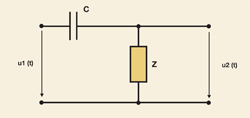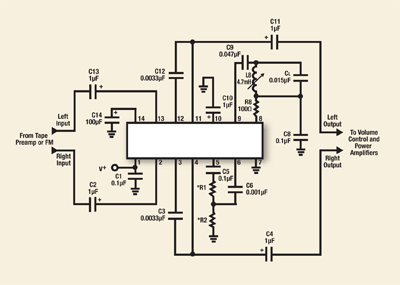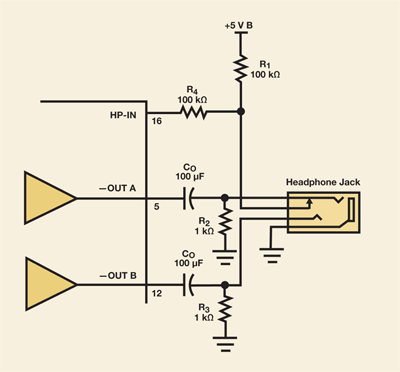Audio coupling with niobium oxide capacitors
NbO technology improves stability over time and temperature for better sound quality
BY CHRIS REYNOLDS
AVX
Myrtle Beach, SC
http://avxcorp.com
There are several technical features required of capacitors used in professional audio and music applications. High-fidelity and noiseless audio-filtering features are necessary without any compromise.
Stability of electrical parameters over temperature and mainly over time is required to assure overall sound quality for long operating times. Some applications, such as portable audio-processing, emphasize miniaturization, which often pushes designers to choose smaller and lower-profile capacitors.
Niobium oxide technology
Niobium oxide (NbO) capacitors are well suited for audio-coupling circuits and have much to offer engineers when compared with other technologies, such as aluminum. Niobium devices combine reliability and stability of time and temperature with the ability to withstand harsh environments such as heat and vibration, while providing low ac ripple.
The clear, noiseless filtering from NbO capacitors meets the requirements of coupling circuits in audio devices and musical instruments for not only high-end consumer products, but also for the latest professional equipment.
Niobium oxide capacitors are available in capacitances from 4.7 to 1,000 mF in voltages from 1.8 to 10 V. Small and low-profile case sizes with heights as low as 1.2 mm are available for headroom-limited applications. Advanced NbO capacitors feature voltages to 10 V, which will fulfill most requirements of today’s electronic devices, as the recommended derating is just 20%.
Capacitors in coupling circuits
Besides decoupling circuits — where capacitors are mostly connected parallel on power-supply lines of signal-processing ICs, amplifiers, etc. — there are coupling circuits where a capacitor directly affects the quality of the treated signal, which is why careful selection is important. The purpose of coupling circuits in audio devices is to separate unwanted dc voltage from useful ac signals, which are allowed through to the next step of signal processing or to the output device.

Fig. 1. This substitutive diagram of coupling circuit is actually a high-pass filter.
Figure 1 is a schematic diagram of coupling circuit that is, in fact, a high-pass filter. C is the coupling capacitor with its nominal capacitance, and Z represents input impedance of the next amplifier, signal processor, or output device such as headphones or a loudspeaker.
For purposes of simple explanation, imagine resistor (R) instead of impedance (Z) with resistance equal to original impedance. Then low-pass frequency is:
fL = 1 / (2πRC)
It’s defined as a signal frequency where voltage transfer ratio is –3 dB. Under this frequency the ratio falls quickly down, above the frequency the ratio raises up to 0 dB, which means no voltage loss.
Selecting capacitance
To choose the right capacitance of a capacitor for coupling circuits, designers should consider the input impedance of the circuit vs. low-pass frequency (see equation), which the human ear hears as a bass tone in the range of 20 to 50 Hz. For coupling circuits to high-input-impedance devices like op-amp inputs, the low capacitance of coupling capacitors can be sufficient for perfect bass-tone transfer. In cases such as line inputs and outputs, capacitors from 1 to 10 µF are usually used (see Fig. 2 ).

Fig. 2. Line input and output coupling capacitors in a stereo dynamic noise-reduction circuit typically requires capacitors to 10 µF.
Coupling of output devices like headphones or loudspeakers is more demanding and requires a higher capacitance value because nominal impedances are in the range of only 4 to 32 Ω. For example, headphones with a ZN of 32 Ω where low-pass frequency is 50 Hz require a 100-µF capacitor (see Fig. 3 ).

Fig. 3. Coupling capacitors in the headphone output circuit of a dual audio amplifier require much higher capacitances.
For headphone coupling in hi-fi and professional devices, it is recommended to use a capacitor featuring a high capacitance value. Loudspeakers with a 4-Ω impedance coupling requires even higher capacitance, and usual values for high-quality devices is 2,000 to 5,000 µF, which can be realized by parallel combinations of several 1,000-µF 4-V capacitors.
NbO vs. aluminum electrolytic
Niobium oxide capacitors do not exhibit the dry-out or wear-out effects suffered by aluminum capacitors. In other words, NbO caps have stable electrical parameters—capacitance, ESR, leakage current—and will not deteriorate sound-quality stability of the application over time.
NbO capacitors offer noise-free performance, important for absolute sound quality. They also exhibit better stability of electrical parameters over temperature, which is an advantage for car audio applications that involve wide temperature ranges in the cabin.
In addition, NbO capacitors feature higher volumetric efficiency than aluminum capacitors, an advantage for use in miniature devices like portable digital sound processors, echoes, gates, microphone amplifiers, and DVD players.
NbO vs. MLCCs
Niobium oxide capacitors do not suffer piezo effect, which, in the case of MLCCs, generates unwelcome additional noise. Another advantage is better stability of parameters over temperature and applied dc bias.
Broad frequency coupling requires high capacitance that remains stable over temperature and applied dc voltage. With no piezoelectric effect, less capacitance variation over temperature, and no voltage dependence, NbO technology is a better fit than MLCCs in coupling circuits.
Sound quality tests
Leading Japanese audio makers performed hearing tests on AVX’s niobium oxide capacitors versus aluminum capacitors in coupling applications and confirmed perfect performance from the NbO technology. Tested parts were 10, 22, 47, and 100 µF in A, B, C, and D case sizes. Tests concluded the sound quality is very qood, even with the lowest-capacitance 10-μF part, and tests using the 100-μF capacitor exhibited high-end sound quality.
World-famous manufacturers of electronic music instruments and audio devices have been testing AVX’s 4.7-, 47-, and 68-µF NOJ capacitors for their instruments. These types are very suitable for audio input and output line coupling circuits perfectly delivering bass part of spectrum, specially 47 µF or 68 μF capacitor.
RoHS and Pb-free compliance
The majority of NbO capacitors are manufactured and tested to comply with the latest Pb-free and RoHs requirements. Capacitors can withstand a threefold reflow profile up to 260°C and comply with JEDEC 020C requirements. ■
Related Products: Capacitor
Advertisement
Learn more about AVX





